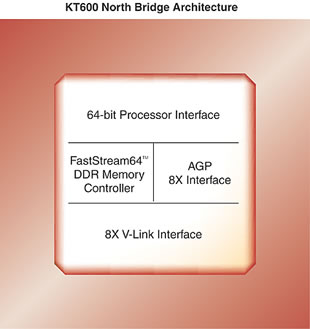KT600, just another name ?
A new chipset usually requires a little discussion before we begin benchmarking in earnest. So let's present a block diagram of the newest VIA AMD chipset. Images are courtesy of VIA Technologies.
We effectively have two new bridges in this chipset, namely the KT600 NB and VT6237 SB. A closer examination of each will help us determine what's new and why it's there.
The KT600's Northbridge specifications seem to be almost identical to the incumbent KT400A's. The differences appear to be limited to simply updating the chipset for the new XP3200 Barton 200FSB CPU. The block diagram highlights the fact that it supports both 400MHz FSB CPUs (200FSB double-pumped) and DDR400 memory. It also supports the slower 200, 266 and 333FSB CPUs, as well as the accompanying memory speeds, naturally. We mentioned that the memory controller has undergone rigorous optimisations over the past year.
The whole idea is to reduce the delay in getting information to and from system memory and the CPU. And if one can employ any form of intelligent prefetching, latencies should be reduced. VIA decide to call this efficient process 'FastStream64' Maybe FastStream400 would have been a catchier title. What we must remember is that VIA have still shied away from introducing a dual memory channel chipset of their own. The KT600 still retains the single memory channel approach. VIA will argue that the double-pumped nature of the Athlon, assuming you're not going to specify any form of on-board graphics, is not really suitable for dual channel running. Of course, more bandwidth is always better, but the question then arises of just how much of the extra bandwidth will be used by the CPU. As the obvious answer here is not all that much, is it really necessary to burden the consumer with an expensive controller that won't realise its potential in this environment ?. The real question, therefore, is whether a little extra performance is worth the extra financial outlay ?. The benchmarks should tell answer this for us later.
An 8x (3.0) AGP interface will keep all modern cards purring along nicely, and the 8X V-Link will provide a bi-directional link to the all-new VT8237 SB. Speaking of which ........, look back at the block diagram and see if you can spy any new features over the present VT8235CE.
A couple of extra USB2.0/1.1 ports have been amalgamated into the new Southbridge, bringing the total up to 8 and matching Intel's new DC chipsets. On-chip SATA is something that we've been waiting for on an AMD motherboard. VIA apply it with a slight twist. The basic on-chip controller allows the use of two ports instantly. You'll see each and every retail KT600 board specify these, much like the ICH5/ However, VIA allow some form of expandability through their SATAlite technology. This will allow a further 2 SATA ports to be run through a SATA PHY (physical layer). The technology is there, it will be up to motherboard manufacturers to implement it as they see fit. 4 SATA ports that work in conjunction with each other will allow RAID0, RAID1, RAID0+1 running. It's SATA heaven.
VIA see no reason why they shouldn't implement their own physical layer for LAN duties. Why go to Realtek when your own VIA 6103 will do the trick ?. Sound may also a closed shop. VIA will probably prefer manufacturers to stick with their 6-channel VT1616 Six-TRAC CODEC, one that we have been relatively impressed by in the past.
One can sometimes infer more about a chipset from looking at what's been left out. There's no inherent FireWire support in the 8237. That's will come as a disappoint to some. There's no new-fangled Wi-Fi or Gigabit LAN (something along the lines of Intel's CSA).
In summary, then, VIA have sought to update their KT400A with official 200FSB CPU support. The KT600 should ship with the improved VT8237 Southbridge, one with native SATA support.










